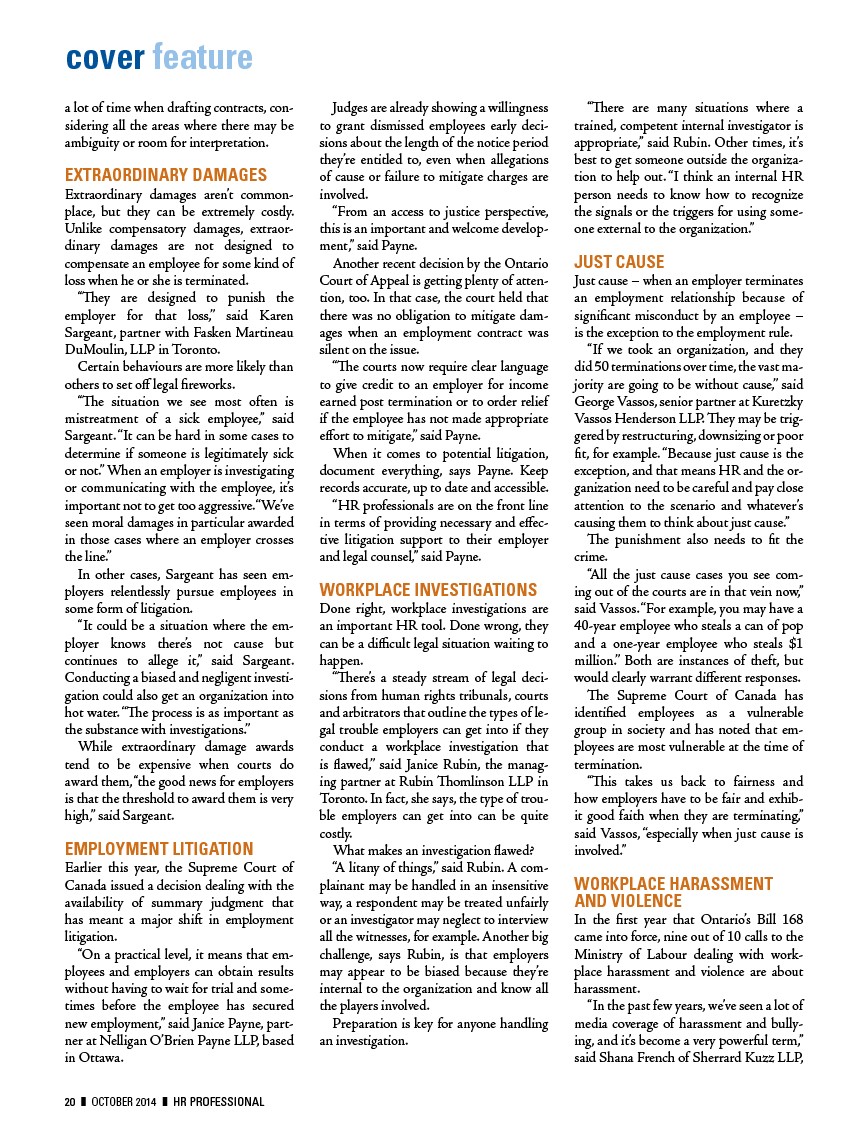
a lot of time when drafting contracts, con-sidering
all the areas where there may be
ambiguity or room for interpretation.
EXTRAORDINARY DAMAGES
Extraordinary damages aren’t common-place,
but they can be extremely costly.
Unlike compensatory damages, extraor-dinary
damages are not designed to
compensate an employee for some kind of
loss when he or she is terminated.
“They are designed to punish the
employer for that loss,” said Karen
Sargeant, partner with Fasken Martineau
DuMoulin, LLP in Toronto.
Certain behaviours are more likely than
others to set off legal fireworks.
“The situation we see most often is
mistreatment of a sick employee,” said
Sargeant. “It can be hard in some cases to
determine if someone is legitimately sick
or not.” When an employer is investigating
or communicating with the employee, it’s
important not to get too aggressive. “We’ve
seen moral damages in particular awarded
in those cases where an employer crosses
the line.”
In other cases, Sargeant has seen em-ployers
relentlessly pursue employees in
some form of litigation.
“It could be a situation where the em-ployer
knows there’s not cause but
continues to allege it,” said Sargeant.
Conducting a biased and negligent investi-gation
could also get an organization into
hot water. “The process is as important as
the substance with investigations.”
While extraordinary damage awards
tend to be expensive when courts do
award them, “the good news for employers
is that the threshold to award them is very
high,” said Sargeant.
EMPLOYMENT LITIGATION
Earlier this year, the Supreme Court of
Canada issued a decision dealing with the
availability of summary judgment that
has meant a major shift in employment
litigation.
“On a practical level, it means that em-ployees
and employers can obtain results
without having to wait for trial and some-times
before the employee has secured
new employment,” said Janice Payne, part-ner
at Nelligan O’Brien Payne LLP, based
in Ottawa.
Judges are already showing a willingness
to grant dismissed employees early deci-sions
about the length of the notice period
they’re entitled to, even when allegations
of cause or failure to mitigate charges are
involved.
“From an access to justice perspective,
this is an important and welcome develop-ment,”
said Payne.
Another recent decision by the Ontario
Court of Appeal is getting plenty of atten-tion,
too. In that case, the court held that
there was no obligation to mitigate dam-ages
when an employment contract was
silent on the issue.
“The courts now require clear language
to give credit to an employer for income
earned post termination or to order relief
if the employee has not made appropriate
effort to mitigate,” said Payne.
When it comes to potential litigation,
document everything, says Payne. Keep
records accurate, up to date and accessible.
“HR professionals are on the front line
in terms of providing necessary and effec-tive
litigation support to their employer
and legal counsel,” said Payne.
WORKPLACE INVESTIGATIONS
Done right, workplace investigations are
an important HR tool. Done wrong, they
can be a difficult legal situation waiting to
happen.
“There’s a steady stream of legal deci-sions
from human rights tribunals, courts
and arbitrators that outline the types of le-gal
trouble employers can get into if they
conduct a workplace investigation that
is flawed,” said Janice Rubin, the manag-ing
partner at Rubin Thomlinson LLP in
Toronto. In fact, she says, the type of trou-ble
employers can get into can be quite
costly.
What makes an investigation flawed?
“A litany of things,” said Rubin. A com-plainant
may be handled in an insensitive
way, a respondent may be treated unfairly
or an investigator may neglect to interview
all the witnesses, for example. Another big
challenge, says Rubin, is that employers
may appear to be biased because they’re
internal to the organization and know all
the players involved.
Preparation is key for anyone handling
an investigation.
cover feature
“There are many situations where a
trained, competent internal investigator is
appropriate,” said Rubin. Other times, it’s
best to get someone outside the organiza-tion
to help out. “I think an internal HR
person needs to know how to recognize
the signals or the triggers for using some-one
external to the organization.”
JUST CAUSE
Just cause – when an employer terminates
an employment relationship because of
significant misconduct by an employee –
is the exception to the employment rule.
“If we took an organization, and they
did 50 terminations over time, the vast ma-jority
are going to be without cause,” said
George Vassos, senior partner at Kuretzky
Vassos Henderson LLP. They may be trig-gered
by restructuring, downsizing or poor
fit, for example. “Because just cause is the
exception, and that means HR and the or-ganization
need to be careful and pay close
attention to the scenario and whatever’s
causing them to think about just cause.”
The punishment also needs to fit the
crime.
“All the just cause cases you see com-ing
out of the courts are in that vein now,”
said Vassos. “For example, you may have a
40-year employee who steals a can of pop
and a one-year employee who steals $1
million.” Both are instances of theft, but
would clearly warrant different responses.
The Supreme Court of Canada has
identified employees as a vulnerable
group in society and has noted that em-ployees
are most vulnerable at the time of
termination.
“This takes us back to fairness and
how employers have to be fair and exhib-it
good faith when they are terminating,”
said Vassos, “especially when just cause is
involved.”
WORKPLACE HARASSMENT
AND VIOLENCE
In the first year that Ontario’s Bill 168
came into force, nine out of 10 calls to the
Ministry of Labour dealing with work-place
harassment and violence are about
harassment.
“In the past few years, we’ve seen a lot of
media coverage of harassment and bully-ing,
and it’s become a very powerful term,”
said Shana French of Sherrard Kuzz LLP,
20 ❚ OCTOBER 2014 ❚ HR PROFESSIONAL